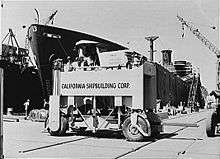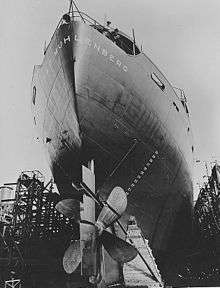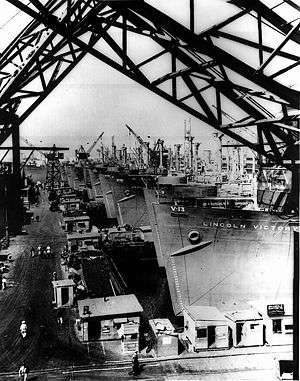California Shipbuilding Corporation
California Shipbuilding Corporation built 467 Liberty and Victory ships during World War II, including Haskell-class attack transports. California Shipbuilding Corporation was often referred to as Calship.[1] The Dictionary of American Naval Fighting Ships sometimes refers to this shipyard as California Shipbuilding Co., but Co[mpany] appears to be an error.


The Calship shipyard was created at Terminal Island in Los Angeles, California, United States as part of America's massive shipbuilding effort of World War II. W. A. Bechtel Co. was given sponsorship and executive direction of Calship. As of 1940, Los Angeles shipyards had not built a large ship in 20 years. By late 1941 though, shipbuilding had become the second largest manufacturing industry in the Los Angeles area.[2][3][4]
Calship was created from scratch and began production of Liberty Ships in May 1941. In the early 1940s, contracts from the U.S.Department of Maritime Commission and a number of U.S. Navy contracts led to prosperity shipbuilding business in Los Angeles. The yard was located on 175 acres on the north side of Terminal Island, north of Dock Street, near present-day berths 210-213. It initially had 8 ways, and later increased this to 14. 40,000 men and women worked under the military contract to construction of 467 vessels over 5 years. The combination of these ships were known as the "Liberty Fleet". These cargo ships were designed for rapid construction with lower costs for them. Thirteen months after commencing production, the yard broke the record by delivering 15 Liberty Ships in June 1942. It delivered 111 ships in 1942, more than any other yard in the United States. In June 1943, it broke the record again by delivering 20 ships for the month, and yet again in December 1943, delivering 23 ships.
Large Navy contracts developed shipbuilding in California. As a result of that, many workers migrated to the work area. Many shipyards sprang up from San Francisco to San Diego. At the peak of shipbuilding in California were involved 282 000 persons. Shipbuilding became a highly efficient wartime industry. The building of vessels and the number of jobs in the shipbuilding peaked in mid-1943.[5][6][7][8][9][10][11][12]
The Kaiser Steel plant in Fontana, California was completed in August 1943, which enabled further production increases at Calship. Between September 27, 1941 and September 27, 1945, the yard launched 467 ships.[13]
The Calship yard was known as "the city built on invisible stilts." It was situated on marshy ground, and was built on artificial earth supported by 57,000 piles driven into the mud. Shipbuilding commenced before the fitting-out docks were even completed. The yard's workers came from every region of the United States, reaching a force of 40,000 men and women, only 1% of whom had any shipbuilding experience whatsoever.[14][15]
After the war, the Maritime Commission and the Navy department were cancelled their contracts with Calship. As the result of that, the level of shipbuilding began to decline. Calship closed in September 1945, after launching the last Victory ship, "four years to the minute after the first slid into the water."[16][17] Calship ranked 49th among United States corporations in the value of World War II military production contracts.[18]
In 1947 the Calship facility was taken over by National Metal & Steel Corporation which operated a scrap yard there. Ironically, 55 of the Liberty and Victory ships that were built at Calship were scrapped on the same site.[19][20]
| Quantity | Design | Type | Use |
|---|---|---|---|
| 306 | EC2-S-C1 | Liberty ship | cargo transport |
| 30 | Z-ET1-S-C3 | Liberty ship | tanker |
| 32 | VC2-S-AP3 | Victory ship | cargo transport, 8,500 hp |
| 30 | VC2-S-AP5 | Haskell class | USN attack transport |
| 69 | VC2-S-AP2 | Victory ship | cargo transport, 6,000 hp |
The surviving museum ships: SS American Victory and SS Lane Victory, were built in the Calship yard. The SS American Victory is in Tampa, Florida and the SS Lane Victory is in Los Angeles. They are open to the public for dockside tours and also sail periodically.[22]


_victory_ship_SS_Lane_Victory_pulls_into_San_Diego_for_Memorial_Day_weekend.jpg)
References
- "Liberty Ships built by California Shipbuilding Corp., Terminal Island, for U. S. Maritime Commission 1941-1945". Retrieved 2006-10-07.
- Nugent, Walter; Ridge, Martin. The American West: The Reader, Indiana University Press, 1999.
- "California Shipbuilding Corp., Los Angeles, California" Project Liberty Ship Web site (http://www.liberty-ship.com/html/yards/californiasb.html Archived 2011-09-27 at the Wayback Machine), retrieved 8-25-2011.
- "California Shipbuilding Corp., Los Angeles," Shipbuilding History Web site (http://shipbuildinghistory.com/history/shipyards/4emergencylarge/wwtwo/kcalifornia.htm Archived 2012-05-10 at the Wayback Machine), Retrieved 8-25-2011.
- "California Shipbuilding Corporation". Retrieved 20 August 2016.
- Jaffee, Capt. Walter W., The Lane Victory: The Last Victory Ship in War and in Peace, 2nd ed., pp. 18, 24-25, The Glencannon Press, Palo Alto, CA, 1997.
- Nugent, Walter; Ridge, Martin. The American West: The Reader, Indiana University Press, 1999.
- Sawyer, L.A. and Mitchell, W.H., The Liberty Ships, 2nd Ed., pp. 20, 61-76, 183-88, 214, 216, Lloyd's of London Press Ltd., London, Eng, 1985.
- "California Shipbuilding Corporation (Calship) Collection, 1941-1945," California State University, Northridge Web site (http://library.csun.edu/Collections/SCA/UAC/CALSHIP Archived 2010-07-09 at the Wayback Machine), Retrieved 8-25-2011.
- Calship Log, Vol. 1, No. 4, October 15, 1941, California Shipbuilding Corporation, Wilmington, California (http://home.comcast.net/~cshortridge/NAVALART/CALSHIP_LOG_10_15_41.pdf), Retrieved 8-25-2011.
- "California Shipbuilding Corp., Los Angeles," Shipbuilding History Web site (http://shipbuildinghistory.com/history/shipyards/4emergencylarge/wwtwo/kcalifornia.htm Archived 2012-05-10 at the Wayback Machine), Retrieved 8-25-2011.
- Herman, Arthur. Freedom's Forge: How American Business Produced Victory in World War II, pp. 137, 178, 258, Random House, New York, NY. ISBN 978-1-4000-6964-4.
- Nugent, Walter; Ridge, Martin. The American West: The Reader, Indiana University Press, 1999.
- "California Shipbuilding Corporation (Calship) Collection, 1941-1945," California State University, Northridge Web site (http://library.csun.edu/Collections/SCA/UAC/CALSHIP Archived 2010-07-09 at the Wayback Machine), Retrieved 8-25-2011.
- "Shipbuilding: Speed on Terminal Island," Time magazine, July 13, 1942 (http://www.time.com/time/magazine/article/0,9171,884558,00.html), Retrieved 8-25-2011.
- "California Shipbuilding Corporation (Calship) Collection, 1941-1945," California State University, Northridge Web site (http://library.csun.edu/Collections/SCA/UAC/CALSHIP Archived 2010-07-09 at the Wayback Machine), Retrieved 8-25-2011.
- "Los Angeles 1943 Pocket Atlas". Retrieved 2007-11-25.
- Peck, Merton J. & Scherer, Frederic M. The Weapons Acquisition Process: An Economic Analysis (1962) Harvard Business School p.619
- Queenan, Charles F. The Port of Los Angeles: From Wilderness to World Port, pp. 84-89, Los Angeles Harbor Department, Los Angeles, CA, 1983.
- White, Michael D. The Port of Los Angeles, pp.78-79, 112, Arcadia Publishing, Charleston, SC, 2008.
- "California Shipbuilding Corp. (CalShip), Los Angeles CA". Archived from the original on 2008-08-20. Retrieved 2010-11-07.
- Jaffee, Capt. Walter W., The Lane Victory: The Last Victory Ship in War and in Peace, 2nd ed., pp. 317-34, The Glencannon Press, Palo Alto, CA, 1997.
Further reading
- Collins, James H. All Aboard! All Aboard! But Where Are the Passengers? Public Utilities Fortnightly, June 24, 1943.
- Herman, Arthur. Freedom's Forge: How American Business Produced Victory in World War II, Random House, New York, NY. ISBN 978-1-4000-6964-4.
- Nugent, Walter; Ridge, Martin. The American West: The Reader, Indiana University Press, 1999.
- Wallace, Jack W. Calship: An Industrial Achievement, 1941-1945, Jack W. Wallace & Associates, 1947.
- Our New West, Popular Mechanics, October 1944.
- Shipbuilding: Speed on Terminal Island, Time, July 13, 1942.
External links
- CSUN.edu: California Shipbuilding Corporation Collection
- Insidesocal.com: History of the California Shipbuilding Corp.
- S.S. American Victory website
- S.S. Lane Victory website